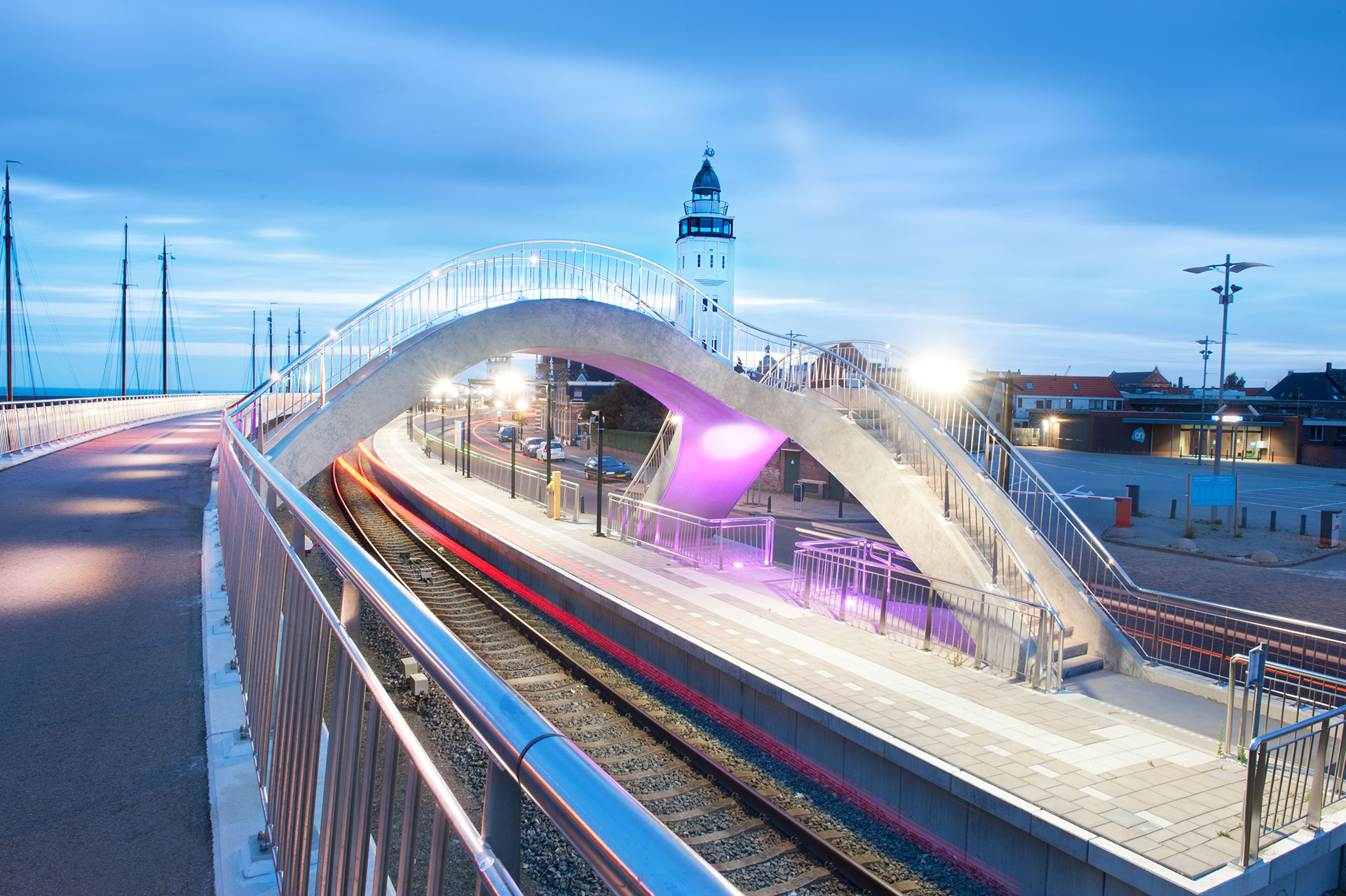Paradis Bridge – Europe’s largest composite truss bridge

Project facts
- ClientStatens Vegvesen
- LocationParadis, Bergen, near Paradis light rail stop
- ChallengeDelivering a maintenance free design that can withstand extreme weather and de-icing salt agents
- SolutionWe designed a hybrid truss with cable stays made for 100% out of Fibre Reinforced Polymers
Why did the project happen?
When Statens vegvesen set out to commission a new pedestrian and cycle bridge in the Paradis neighbourhood of Bergen, it had clear aspirations for a design that was low maintenance, but capable of withstanding the extremes of Norway’s icy weather – and the de-icing salting agents used to mitigate it.
These aspirations were informed, in part, by Norway’s wider exploration of lightweight, low-maintenance bridges near light rail infrastructure. Inspiration was taken from the Netherlands, where lightweight composite bridges are already in use in pedestrian, and even traffic bridges.
After a restructuring of bridge allocations in Norway, bridge ownership transferred to the Vestland fylkeskommune (Vestland County Municipality). The Municipality began an international tender process to find a team capable of achieving its vision.
Norwegian ingenuity, Dutch design
For Statens vegvesen, Royal HaskoningDHV prepared the architectural reference design and demonstrated the technical feasibility. In the tender preparation phase for Vestland fylkeskommune, we consulted on the composite-specific technical specifications for the contract, including standards to be used and tests and checks to be executed. We also provided a technical support role in assessing the proposals and supporting the selection procedure.
The design phase was organised in a collaborative building alliance form. In collaboration with the Municipality and consortium chosen to realise Vestland fylkeskommune’s aspirations, our proposed design was elaborated. The structure would be made fully of composite materials – including fibreglass and carbon fibre. Royal HaskoningDHV provided technological guidance throughout the project, including the composite quality control and checks for design, production, and installation.
One change that was made in the design phase was to pre-fabricate the bridge in a single piece in Arendal, in the south of Norway. This came with major advantages for the quality of the bridge’s assembly and prevented disruption at the bridge’s eventual location near Bergen’s light railway. And it made for a spectacular transport too.
The bridge is unique and the first of its kind due to the scale and complexity. With the extensive knowledge of composite material, design, and design standards, Royal HaskoningDHV was able to create and execute dedicated quality checks, making sure the bridge was designed and produced to meet the requirements of the Eurocode and Municipality.

Royal HaskoningDHV has proven to be a valuable partner in the process of applying this innovative technology reliably, with composite design, and quality assurance.
A journey over land and sea
With its changes in the design, the final resulting bridge still very much reflects the architectural design and technical aspirations of the reference design.The bridge, 42 metres long, seven metres wide and six metres high, made its more than 250-mile journey from Arendal to Bergen, in three stages – first by sea, then via inland waterways, and finally over land. A journey that takes eight minutes by car took four hours!
In that final stage of the journey across land, road signs were removed, lampposts moved, and cables lifted to make room. Many schoolchildren, who will use the bridge as a safe crossing to their school, gathered to watch its final leg through Bergen. And due to its innovative character, it even made the national news on three consecutive days of its transport and the final installation.
The composite Paradis Bridge was installed in just an hour in the middle of the night, outside the operating hours of the light rail. The bridge realises Vestland’s vision and even honours the municipality with the blue of Vestland fylkeskommune on the inside of the bridge triangles. It also represents another positive step for composite technology.
With no steel in the structure, the bridge is extremely low maintenance and should stand for 100 years with recommended cleaning – meaning not only did it cause little disruption during its installation, but it will also cause very little future disruption for the light rail below it.

The defining features of Paradis Bridge

Extremely low maintenance
Due to the use of non-corrosive composite material, the bridge is extremely low in maintenance.

Lightweight
The weight of the bridge is only 47 tonnes, which allowed the transportation as a fully assembled structure, with the use of a smaller, single crane, reducing time and costs in the installation. The bridge was lifted in place in just one hour.

Composite architecture
Royal HaskoningDHV is the leading engineering firm within Europe for composite bridge design with in-house expertise on architecture, engineering of bridges, and composite materials.


Bridge solutions for thriving societies

Infrastructureenquiries
Contact our Infra experts
Join our team
